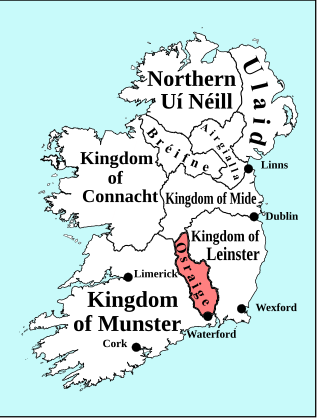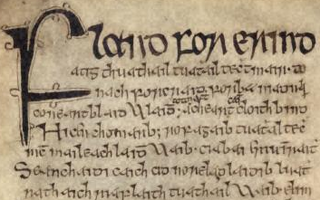Related Research Articles
Áed mac Néill, called Áed Findliath to distinguish him from his paternal grandfather Áed Oirdnide, was king of Ailech and High King of Ireland. He was also called Áed Olach according to Baile in Scáil, section 51. A member of the northern Uí Néill kindred of the Cenél nEógain, Áed was the son of Niall Caille.

The kings of Osraige reigned over the medieval Irish kingdom of Osraige from the first or second century AD until the late twelfth century. Osraige was a semi-provincial kingdom in south-east Ireland which disappeared following the Norman Invasion of Ireland. A number of important royal Ossorian genealogies are preserved, particularly MS Rawlinson B502, which traces the medieval Mac Giolla Phádraig dynasty back through Óengus Osrithe, who supposedly flourished in the first or second century. and one in the Book of Leinster. Recent analysis of ninth and tenth century regnal succession in Osraige has suggested that in peaceful times, kingship passed primarily from eldest to youngest brother, before crossing generations and passing to sons and nephews.

Osraige or Osraighe, Osraí, anglicized as Ossory, was a medieval Irish kingdom comprising what is now County Kilkenny and western County Laois, corresponding to the Diocese of Ossory. The home of the Osraige people, it existed from around the first century until the Norman invasion of Ireland in the 12th century. It was ruled by the Dál Birn dynasty, whose medieval descendants assumed the surname Mac Giolla Phádraig.
Ruarc mac Brain was the fourth of ten Kings of Leinster to be inaugurated and based on Lyons Hill, Ardclough, County Kildare, a member of the Uí Dúnchada, one of three septs of the Uí Dúnlainge dynasty which rotated the kingship of Leinster between 750 and 1050, significant in County Kildare History.

Flann Sinna, also known as Flann mac Máel Sechnaill, was the son of Máel Sechnaill mac Máele Ruanaid of Clann Cholmáin, a branch of the Southern Uí Néill. He was King of Mide from 877 onwards and a High King of Ireland. His mother Land ingen Dúngaile was a sister of Cerball mac Dúnlainge, King of Osraige.
Máel Sechnaill mac Máel Ruanaida, also known as Máel Sechnaill I, anglicised as Malachy MacMulrooney was High King of Ireland. The Annals of Ulster use the Old Irish title rí hÉrenn uile, that is "king of all Ireland", when reporting his death, distinguishing Máel Sechnaill from the usual Kings of Tara who are only called High Kings of Ireland in late sources such as the Annals of the Four Masters or Geoffrey Keating's Foras Feasa ar Éirinn. According to the "Grand History of the Celts", a traditional book of facts and folklore, Mael Sechnaill was the husband of Mael Muire, the granddaughter of the legendary Alpin, a 9th-century king of Dalriada.
Cerball mac Dúnlainge was king of Ossory in south-east Ireland. The kingdom of Ossory (Osraige) occupied roughly the area of modern County Kilkenny and western County Laois and lay between the larger provincial kingdoms of Munster and Leinster.
Muirchertach mac Néill, called Muirchertach of the Leather Cloaks, was a King of Ailech.
Vilbaldr Dufþaksson was a Norse-Gael settler in Iceland, mentioned in the Landnámabók. He was the great-grandson of Cerball mac Dúnlainge, king of Osraige from 842 to 888, via an otherwise unknown son of Cerball, called Dufnial (Domnall). His brother was one Askell hnokkan, and his sons were Bjouok and Bjolan.
Conchobar mac Taidg Mór was a King of Connacht from the Uí Briúin branch of the Connachta. He was the grandson of Muirgius mac Tommaltaig, a previous king. His father Tadg Mór had been slain fighting in Muirgius' wars versus the minor tribes of Connacht. He was of the Síl Muiredaig sept of the Uí Briúin. The Ó Conchobhair septs of Connacht are named for him.
Muirecán mac Diarmata was a King of Leinster of the Uí Fáeláin sept of the Uí Dúnlainge branch of the Laigin. This sept had their royal seat at Naas in the eastern part of the Liffey plain, Airthir Liphi. He was the son of Diarmait mac Ruadrach, King of Airthir Liphi. His uncle Muiredach mac Ruadrach and grandfather Ruaidrí mac Fáeláin were Kings of Leinster.
Máel mac Donngaile, known as Máel Gualae, was a King of Munster from the Eóganacht Chaisil branch of the Eoganachta, the ruling dynasty of Munster. He was of the Clann Faílbe sept of this branch and a grandson of Tnúthgal mac Donngaile, whom some sources name as King of Munster and brother of Áilgenán mac Donngaile, also King of Munster. His branch of the ruling dynasty had their lands in the Cashel area of modern County Tipperary. He reigned from 856 to 859.
Gormflaith ingen Flann Sinna was an Irish Queen of Tara, Munster, and Leinster.
The Battle of Ballaghmoon took place on 13 September 908 at Ballaghmoon, near Castledermot in the south of modern County Kildare. It pitted the forces of Cormac mac Cuilennáin, king of Munster against an alliance comprising the forces of Flann Sinna, High King of Ireland, Cerball mac Muirecáin, king of Leinster, Cathal mac Conchobair, king of Connacht, and Cellach mac Cerbaill, king of Osraige. It ended in a decisive victory for the alliance led by Flann Sinna.
Dúngal mac Fergaile was king of Osraige from 802 until his death in 842.
Riagan mac Dúnlainge was king of Osraige from 888 to 894 AD.
Cellach mac Cerbaill was king of Osraige from 905 to his death in 908.
Land ingen Dúngaile was a Dál Birn princess of Osraige who was a noteworthy figure in Irish politics during a critical time in Viking-age Ireland.
Gilla Pátraic mac Donnchada was king of Osraige and the progenitor from whom all Mac Giolla Phádraigs (Fitzpatricks) of Ossory took their hereditary surname. Gilla Pátraic succeeded his father Donnchad mac Cellaig in 976. Donnchad mac Cellaig was the son of Cellach mac Cerbaill, king of Osraige and his wife, Echrad ingen Matudán. After a reign of 21 years, Gilla Pátraic was slain by Donnabhan, king of the Danes of Waterford, and Domhnall, king of the Desies. By his wife, Maelmuire, he had five sons: (1) Donnchad mac Gilla Pátraic, king of Osraige and king of Leinster; (2) Dunghal ; (3) Tadhg ; (4) Diarmaid ; and, (5) Muircheartach.
Donnchad mac Cellaig reigned as king of Osraige from AD 934 to 976. He was the son of Cellach mac Cerbaill, king of Osraige and his wife, Echrad ingen Matudán. He succeeded to the throne on the death of his brother Cuilen, and ruled his native territory with great distinction and credit to himself for more than 40 years.
References
- ↑ M891.16
- ↑ AI894.1
- ↑ U928.6
- ↑ William Carrigan (1905). The history and antiquities of the diocese of Ossory. Vol. I. Sealy, Bryers & Walker. pp. 41–44.
- ↑ "Banshenchus". Archived from the original on 6 October 2016. Retrieved 4 December 2015.